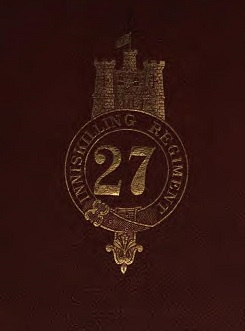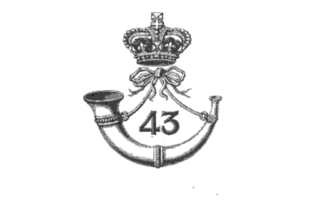The 28th Regiment of Foot was a line infantry regiment of the British Army, raised in 1694. Under the Childers Reforms it amalgamated with the 61st Regiment of Foot to form the Gloucestershire Regiment in 1881.

The 50th Regiment of Foot was an infantry regiment of the British Army, raised in 1755. Under the Childers Reforms it amalgamated with the 97th Regiment of Foot to form the Queen's Own Royal West Kent Regiment in 1881.

The 55th Regiment of Foot was a British Army infantry regiment, raised in 1755. After 1782 it had a county designation added, becoming known as the 55th (Westmorland) Regiment of Foot. Under the Childers Reforms it amalgamated with the 34th (Cumberland) Regiment of Foot to form the Border Regiment in 1881.
The 38th Regiment of Foot was an infantry regiment of the British Army, raised in 1705. Under the Childers Reforms it amalgamated with the 80th Regiment of Foot to form the South Staffordshire Regiment in 1881.
The 65th Regiment of Foot was an infantry regiment of the British Army, raised in 1756 as the 2nd Battalion, 12th Regiment of Foot. Under the Childers Reforms it amalgamated with the 84th Regiment of Foot to become the 1st Battalion, York and Lancaster Regiment in 1881.

The 27th (Inniskilling) Regiment of Foot was an Irish infantry regiment of the British Army, formed in 1689. Under the Childers Reforms it amalgamated with the 108th Regiment of Foot to form the Royal Inniskilling Fusiliers in 1881.
The 37th Regiment of Foot was a line infantry regiment of the British Army, raised in Ireland in February 1702. Under the Childers Reforms it amalgamated with the 67th Regiment of Foot to become the Hampshire Regiment in 1881.

The 67th Regiment of Foot was a line infantry regiment of the British Army, raised in 1756. Under the Childers Reforms it amalgamated with the 37th Regiment of Foot to form the Hampshire Regiment in 1881.

The 46th Regiment of Foot was an infantry regiment of the British Army, raised in 1741. Under the Childers Reforms it amalgamated with the 32nd (Cornwall) Regiment of Foot to form the Duke of Cornwall's Light Infantry in 1881, becoming the 2nd Battalion of the new regiment.
The 100th Regiment of Foot, also known as Campbell's Highlanders, was an infantry regiment of the British Army, formed in 1760 and disbanded in 1763.
The 87th Regiment of Foot (Keith's Highlanders) was a Scottish infantry regiment in the British Army, formed in 1759 and disbanded in 1763.
The 48th (Northamptonshire) Regiment of Foot was a regiment of the British Army, raised in 1741. Under the Childers Reforms it amalgamated with the 58th (Rutlandshire) Regiment of Foot to form the Northamptonshire Regiment in 1881.

The 43rd (Monmouthshire) Regiment of Foot was an infantry regiment of the British Army, raised in 1741. Under the Childers Reforms it amalgamated with the 52nd (Oxfordshire) Regiment of Foot to form the 1st and 2nd battalions of the Oxfordshire Light Infantry in 1881. The regiment went on to become the Oxfordshire and Buckinghamshire Light Infantry in 1908.
The 108th Regiment of Foot was an infantry regiment of the British Army from 1761 to 1763. It was raised in October 1761 from a cadre of the 31st Regiment of Foot, and was disbanded in 1763.
The 51st Regiment of Foot was a British Army line infantry regiment, raised in 1755. Under the Childers Reforms it amalgamated with the 105th Regiment of Foot to form the King's Own Yorkshire Light Infantry in 1881.
The 91st Regiment of Foot had a brief existence as a British Army infantry regiment between 1759 and 1763. It was raised in Ireland, posted in turn to the West Indies and the Iberian Peninsula and finally disbanded in 1763. Some of the personnel then transferred to the 3rd Regiment of Foot, then stationed in Menorca. The Regimental Colonel throughout its life was Lt-Gen. Cadwallader Blayney, 9th Baron Blayney who had fought at the Battle of Minden in August 1759.
The 75th Regiment of Foot was an infantry regiment of the British Army from 1758 to 1763.
The 85th Regiment of Foot (Westminster Volunteers) was a short-lived infantry Regiment in the British Army which was raised in 1777 to provide garrison troops for the West Indies during the American Revolutionary War.
The 85th Regiment of Foot was a short-lived British Army regiment during the Seven Years' War. It was recruited at Shrewsbury in 1759 as the first full regiment of light infantry in the British Army and originally intended for service in the North American campaign.

The 2nd Somerset Militia was an auxiliary military regiment in the county of Somerset in South West England. First organised during the Seven Years' War it was reformed at the start of the French Revolutionary War and continued on internal security and home defence duties in all of Britain's major wars. It later became a battalion of the Somerset Light Infantry and served in South Africa during the Second Boer War, but was disbanded in 1908.






